|
|
 |
Baked Cookies+Creme Cheesecake—Prototype 1
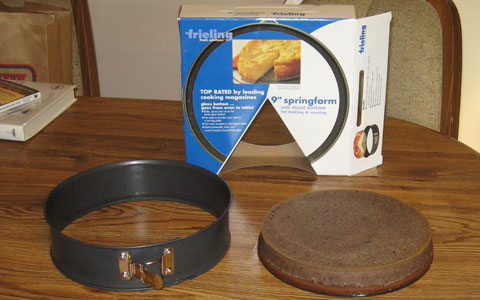
Crust:
4 oz. semi-sweet chocolate, melted
1 1/3 tablespoons cocoa powder
1 cup (8 oz.) lowfat cottage cheese, whipped, no salt added
3/8 cup granulated sugar
1 teaspoon vanilla (next to last ingredient here)
2.2 oz. Bran Buds, ground up
Batter:
2 tablespoons melted or softened butter
1/2 cup granulated sugar
1/2 cup skim milk
1 tablespoon lemon juice
1/3 cup flour
1/4 teaspoon salt
2 1/2 cups (20 oz.) lowfat cottage cheese, whipped, no salt added
1 teaspoon vanilla
2 eggs
12 chocolate sandwich cookies, crushed (add this last, and mix enough to get
it blended in)
Bake in a tub at 300 degrees for about 100 minutes.
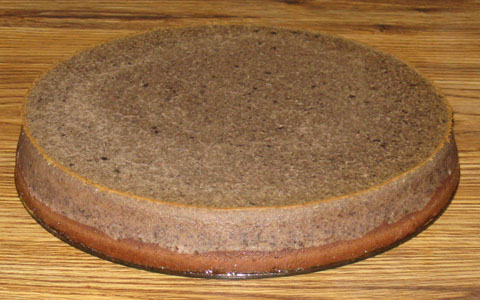
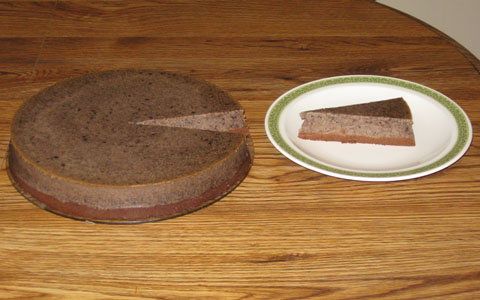
Baked Cookies+Creme Cheesecake—Prototype 2
Repeat Prototype 1, but boost the batter's sandwich cookies by 4, to 16.
Also, cut the baking time to only about 90 minutes.
Baked Cookies+Creme Cheesecake—Prototype 3:
Repeat Prototype 2, but upon adding the crushed cookies, make sure that they
are only folded into the batter. Keep that blender, mixer, or
whatever food processor is used, shut off at this point! Then
transfer all this to the pan.
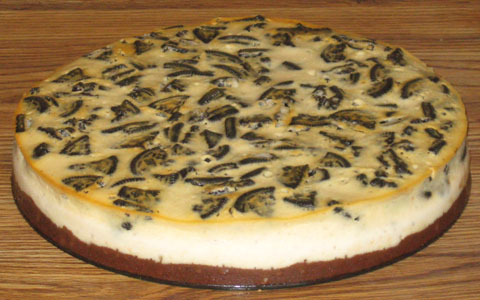
Baked Cookies+Creme Cheesecake—Prototype 4:
Repeat Prototype 3, but make up a mixture of 1/2 cup of skim milk and 1 tablespoon
of granulated sugar, and soak the cookies—lightly broken up—in this
mixture, until the chocolate outer cookies soften. Then fold all this into
the cheesecake batter before baking. (Note that the milk for this
"soaking" mixture is in addition to the 1/2 cup already
used in the batter. So one full cup of milk is used altogether for this
recipe. In fact, if it becomes difficult getting all the cookies moistened,
at least some of the 1/2 cup of milk intended directly for the batter could
instead be shifted to the cookie mixture.)
Baked Cookies+Creme Cheesecake—Prototype 5:
Crust:
4 oz. semi-sweet chocolate, melted
1 1/3 tablespoons cocoa powder
8 oz. yogurt cheese (half of it lowfat, the other half nonfat)
3/8 cup granulated sugar
1 teaspoon vanilla
2.2 oz. Bran Buds, ground up
Batter:
2 tablespoons melted or softened butter
1 cup granulated sugar
1/3 cup flour
1/4 teaspoon salt
20 oz. yogurt cheese (half of it lowfat, the other half nonfat)
1 teaspoon vanilla
2 eggs
Cookie Mixture:
16 chocolate sandwich cookies, broken preferably in halves (at least make a
reasonable effort here)
1/2 cup skim milk
Fill a resealable ("Ziploc") sandwich or 1-quart bag with the 16
cookies and 1/2 cup skim milk. Seal this bag and shake it to distribute the milk
and moisten the cookies. Refrigerate for a few hours. Then add this to the
batter before baking.
Bake the cheesecake in a tub for about an hour at 300 degrees. Cool it down
afterwards for about 90 minutes before refrigerating.
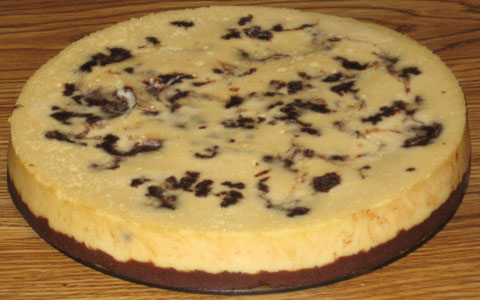
Baked Cookies+Creme Cheesecake—Prototype 6:
2-to-1 Blend of Yogurt Cheese and Cottage Cheese:
Prepare ahead of time 1 pound of yogurt cheese, derived from one 32-ounce
container of nonfat yogurt. If the resulting yogurt cheese falls below 16
ounces, add back enough of the whey (that was strained out from the yogurt) to
make up the difference. To this yogurt cheese combine 8 ounces (1 cup) of
whipped, lowfat cottage cheese.
Crust:
2 oz. semi-sweet chocolate, melted
2 teaspoons cocoa powder
4 oz. (1/2 cup) 2-to-1 blend of yogurt cheese and cottage cheese (see above)
3 tablespoons granulated sugar
1/2 teaspoon vanilla
1.1 oz. Bran Buds, ground up
Batter:
2 tablespoons melted or softened butter
5/8 cup granulated sugar
2 tablespoons all-purpose flour
1 1/3 tablespoons arrowroot
1/4 teaspoon salt
20 oz. (2 1/2 cups) 2-to-1 blend of yogurt cheese and cottage cheese (see above)
1 teaspoon vanilla
2 eggs
Cookie Mixture:
1/4 cup skim milk
1/2 tablespoon granulated sugar
16 chocolate sandwich cookies (such as Back To Nature Classic Creme Cookies), broken
preferably in halves (at least make a reasonable effort here)
Blend the milk and 1/2 tablespoon of sugar together. Place the cookies in a
resealable ("Ziploc") sandwich or 1-quart bag, then add the
milk-and-sugar mixture to it. Close the bag and shake it to distribute the wet
mixture and moisten the cookies. Let this sit for about 1 or 2 minutes. Then add
the contents to the batter before baking.
Bake the cheesecake in a tub at 300 degrees for 60 minutes (if using a 9
1/2" pan), cool (outside of oven and tub) for an hour, remove from pan and
refrigerate (adding a border of chocolate chips on top of the cheesecake, while
it is warm, is a suggested option).
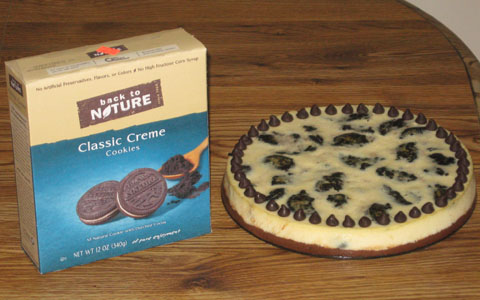
Baked Cookies+Creme Cheesecake—Prototype 7:
2-to-1 Blend of Yogurt Cheese and Cottage Cheese:
Prepare ahead of time 32 ounces of yogurt cheese, derived from two 32-ounce
containers (that's 64 ounces altogether) of nonfat yogurt. If the resulting
yogurt cheese falls below 32 ounces, add back enough of the whey (that was
strained out from the yogurt) to make up the difference. To this yogurt cheese
combine one 16-ounce container of whipped, lowfat cottage cheese.
Crust:
4 oz. semi-sweet chocolate, melted
1 1/3 tablespoons cocoa powder
8 oz. (1 cup) 2-to-1 blend of yogurt cheese and cottage cheese (see above)
3/8 cup granulated sugar
1 teaspoon vanilla
2.2 oz. finely ground Bran Buds
Batter:
4 tablespoons melted or softened butter
1 1/4 cups granulated sugar
1/4 cup all-purpose flour
3 tablespoons arrowroot
1/2 teaspoon salt
40 oz. (5 cups) 2-to-1 blend of yogurt cheese and cottage cheese (see above)
2 teaspoons vanilla
4 eggs
Cookies:
32 chocolate sandwich cookies (such as Back To Nature Classic Creme Cookies),
broken preferably in halves
Pour the batter on top of the crust. Do not pre-soak the cookies. Simply
add them, broken up, directly to the batter before baking.
Bake the cheesecake in a tub at 300 degrees for 105 minutes (if using a 9
1/2" pan). Then cool the cheesecake down while still in oven (with this
oven shut off) and in tub with door slightly ajar for an hour. Afterwards,
remove from oven and tub and continue to cool down at room temperature for
another 105 minutes (if desired, add a border of chocolate chips while
cheesecake is still warm), then remove from pan and refrigerate.
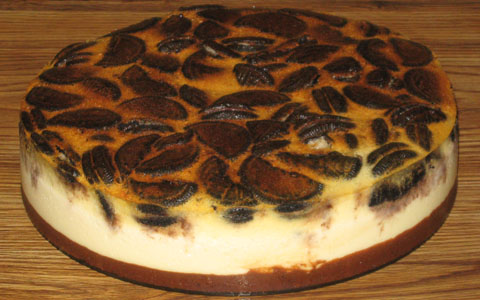
Baked Cookies+Creme Cheesecake—Prototype 8:
Yogurt Cheese:
Prepare ahead of time 3 pounds of yogurt cheese, derived from three 32-ounce
containers of nonfat yogurt. If the resulting yogurt cheese falls below 48
ounces, add back enough of the whey (that was strained out from the yogurt) to
make up the difference.
Crust:
4 oz. semi-sweet chocolate, melted
2 tablespoons cocoa powder
8 oz. (1 cup) yogurt cheese (see above)
3/8 cup granulated sugar
1 teaspoon vanilla
2 oz. finely ground Bran Buds
Place all this into a 9 or 9 1/2 inch springform pan.
Batter:
4 tablespoons melted or softened butter
1 1/4 cups granulated sugar
1/4 cup all-purpose flour
3 tablespoons arrowroot
1/2 teaspoon salt
40 oz. (5 cups) yogurt cheese (see above)
2 teaspoons vanilla
4 eggs
Cookies:
1 package, a 12-ounce size or—if package is a different size—12
ounces, of chocolate sandwich cookies, broken preferably in halves (Back To
Nature Classic Creme Cookies are recommended—not only for their great,
all-natural taste, but these were found in 12-ounce packages)
Expect about 7 cups of the resulting batter, but do not add this to the pan all
at once. Rather, this needs to be done in five installments. Wrap the pan in
foil just before adding the first installment. Minimize the foil's disturbance
in order to minimize its leakage risk.
For each of the first four installments, add about 1 1/2 cups of batter and one
fourth of the cookies to the pan. There is no need to be exact—evenly
distributing the cookies is the intent here. Because of this, use extra care in
the later installments when adding contents (i.e., do it gently) to the pan.
Ensure that the cookies are fully coated, and immersed as much as possible.
After adding the installment, bake the pan with its contents for 15 minutes. For
each of the first three installments, bake at 325 degrees. For the fourth
installment, reduce the temperature and bake at 300 degrees. For all four
installments here, bake with the pan in a tub filled with at least 1/4 to 1/2
inch of boiling water, but (to reduce spillage risks) do not fill the tub all
the way at this point, because the whole tub-and-pan assembly is going to need
to be removed from the oven (in order to comfortably add contents to the pan)
between installments.
After all this is done, there should be about a cup of batter but no cookies
remaining, with 60 minutes of baking time reached at this point (15 minutes for
each of the first four installments). Now comes the fifth installment—carefully
add the last of this batter on top of the pan's other contents. Try to fully
coat the entire surface, especially wherever cookie pieces may be showing. Next,
return the entire pan-and-tub assembly to the oven. At this point, fill up the
tub generously with boiling water. Resume baking at 300 degrees for another 55
minutes (based upon usage of a 9 1/2" pan).
Afterward, shut the oven off, and leave its door slightly ajar, with the
cheesecake still inside—and in the tub—for an hour. Next, remove the
cheesecake from the oven and tub, and—if desired—add a border of
chocolate chips around the edge of this cheesecake. Continue to cool it down at
room temperature for another two hours. After doing so, remove the cheesecake
from pan and refrigerate.
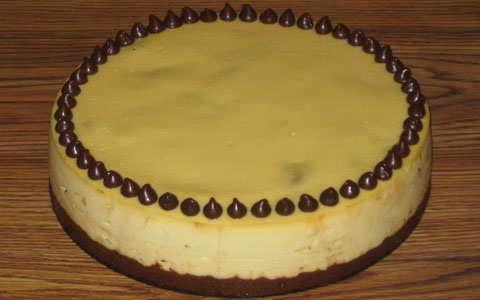
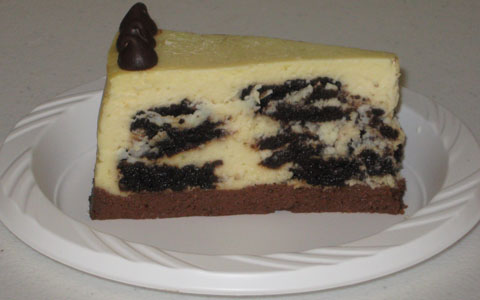
Baked Cookies+Creme Cheesecake—Prototype 9:
Yogurt Cheese:
Prepare ahead of time 3 pounds of yogurt cheese, derived from three 32-ounce
containers of nonfat yogurt. If the resulting yogurt cheese falls below 48
ounces, add back enough of the whey (that was strained out from the yogurt) to
make up the difference.
Crust:
4 oz. semi-sweet chocolate, melted
2 tablespoons cocoa powder
8 oz. (1 cup) yogurt cheese (see above)
3/8 cup granulated sugar
1 teaspoon vanilla
2 oz. finely ground All-Bran
Pour this crust mixture into bottom of greased springform pan (9 to 9 1/2
inches) and pre-bake without tub at 300 degrees for 10 minutes, then cool enough
to comfortably touch at least the pan's upper sidewall.
Batter:
4 tablespoons melted or softened butter
1 1/4 cups granulated sugar
1/4 cup all-purpose flour
3 tablespoons arrowroot
40 oz. (5 cups) yogurt cheese (see above)
2 teaspoons vanilla
4 eggs
Cookies:
Chocolate sandwich cookies (with vanilla creme centers), about 2 dozen (Back To
Nature Classic Creme Cookies recommended)
Expect about 7 cups of the resulting batter, but do not add this to the pan all
at once. Rather, this needs to be done in five installments. Wrap the pan in
foil just before adding the first installment. Minimize the foil's disturbance
in order to minimize its leakage risk.
For each of the first four installments, gently scoop about 1 1/2 cups of batter
into the pan. Add about 6 cookies (don't bother breaking them up—keeping
them whole is fine and, in fact, recommended), ensuring that they are fully
coated and—as much as possible—immersed. After adding an
installment, bake the pan with its contents for 15 minutes. For each of the
first three installments, bake at 325 degrees. For the fourth installment,
reduce the temperature and bake at 300 degrees. For all four installments here,
bake with the pan in a tub filled with at least 1/4 to 1/2 inch of boiling
water, but (to reduce spillage risks) do not fill the tub all the way at this
point, because the whole tub-and-pan assembly is going to need to be removed
from the oven (in order to comfortably add contents to the pan) between
installments.
After all this is done, there should be about a cup of batter left, with 60
minutes of baking time reached at this point (15 minutes for each of the first
four installments). Now comes the fifth installment—carefully add the last
of this batter (do not add any more cookies at this point) on top of the pan's
other contents. Try to fully coat the entire surface, especially wherever cookie
pieces may be showing. Next, return the entire pan-and-tub assembly to the oven.
At this point, fill up the tub generously with boiling water. Resume baking at
300 degrees for another 55 minutes (based upon usage of a 9 1/2" pan).
Afterward, shut the oven off, and leave its door slightly ajar, with the
cheesecake still inside—and in the tub—for an hour. Next, remove the
cheesecake from the oven and tub, and—if desired—add a border of
chocolate chips around the edge of this cheesecake. Continue to cool it down at
room temperature for another two hours. After doing so, remove the cheesecake
from pan and refrigerate.
Baked Cookies+Creme Cheesecake—Prototype 10:
3-Cheese Blend (1CT-1NC-4YG):
Prepare ahead of time 32 ounces of yogurt cheese, derived from two 32-ounce
containers (that's 64 ounces altogether) of nonfat yogurt. If the resulting
yogurt cheese falls below 32 ounces, add back enough of the whey (that was
strained out from the yogurt) to make up the difference. To this yogurt cheese
combine 8 ounces of whipped, lowfat cottage cheese and 8 ounces of softened
Neufchatel cheese ("light cream cheese").
Grease a 9 1/2" (or 9") springform pan, but do not wrap foil around it
yet (see below).
Crust:
4 oz. semi-sweet chocolate, melted
3/8 cup granulated sugar
2 tablespoons cocoa powder
8 oz. (1 cup) 3-cheese blend (see above)
1 teaspoon vanilla
2 oz. finely ground All-Bran
Place the resulting mixture in the greased pan and pre-bake without tub at 300
degrees for 5-10 minutes, depending on the mixture's thickness (closer to 10
minutes if thin enough to be fully distributed across the pan's bottom by gentle
shaking, closer to 5 minutes if thick enough to require spreading out this
mixture by pressing on it with a utensil and/or fingers), then cool enough to
comfortably touch at least the pan's upper sidewall.
Batter:
1 1/4 cups granulated sugar
40 oz. (5 cups) 3-cheese blend (see above)
2 teaspoons vanilla
1/4 cup + 1 tablespoon (5 tablespoons altogether) arrowroot
5 eggs
Cookies:
Chocolate sandwich cookies (with vanilla creme centers), about 2 dozen (Back To
Nature Classic Creme Cookies recommended)
Expect about 7 cups of the resulting batter, but do not add this to the pan all
at once. Rather, this needs to be done in five installments. Wrap the pan in
foil just before adding the first installment (to minimize the foil's
disturbance and therefore its leakage risk, do not put it on any earlier).
For each of the first four installments, gently scoop about 1 1/2 cups of batter
into the pan. Add about 6 cookies (don't bother breaking them up—keeping
them whole is fine and, in fact, recommended), ensuring that they are fully
coated and—as much as possible—immersed. After adding an
installment, bake the pan with its contents for 15 minutes. For each of the
first three installments, bake at 325 degrees. For the fourth installment,
reduce the temperature and bake at 300 degrees. For all four installments here,
bake with the pan in a tub filled with at least 1/4 to 1/2 inch of boiling
water, but (to reduce spillage risks) do not fill the tub all the way at this
point, because the whole tub-and-pan assembly is going to need to be removed
from the oven (in order to comfortably add contents to the pan) between
installments.
After all this is done, there should be about a cup of batter left, with 60
minutes of baking time reached at this point (15 minutes for each of the first
four installments). Now comes the fifth installment—carefully add the last
of this batter (do not add any more cookies at this point) on top of the pan's
other contents. Try to fully coat the entire surface, especially wherever cookie
pieces may be showing. Next, return the entire pan-and-tub assembly to the oven.
At this point, fill up the tub generously with boiling water. Resume baking at
300 degrees for another 80 minutes (based upon usage of a 9 1/2" pan).
Afterward, shut the oven off, and leave its door slightly ajar, with the
cheesecake still inside—and in the tub—for an hour. Next, remove the
cheesecake from the oven and tub, and—if desired—add a border of
chocolate chips around the edge of this cheesecake. Continue to cool it down at
room temperature for another two hours. After doing so, remove the cheesecake
from pan and refrigerate.
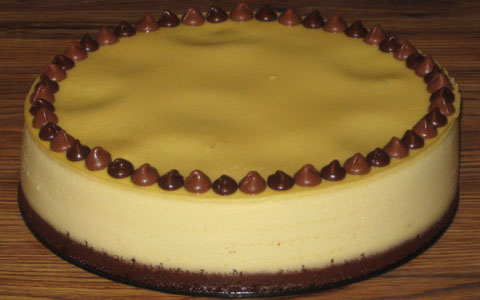
Baked Cookies+Creme Cheesecake—Prototype 11:
3-Cheese Blend (1CT-1NC-1YG):
Prepare ahead of time 16 ounces of yogurt cheese, derived from one 32-ounce
container of nonfat yogurt. If the resulting yogurt cheese falls below 16
ounces, add back enough of the whey (that was strained out from the yogurt) to
make up the difference. To this yogurt cheese combine 16 ounces of whipped,
lowfat cottage cheese and 16 ounces (two 8-ounce packages) of softened
Neufchatel cheese ("light cream cheese").
Grease a 9 1/2" (or 9") springform pan, but do not wrap foil around it
yet (see below).
Crust:
4 oz. semi-sweet chocolate, melted
3/8 cup granulated sugar
2 tablespoons cocoa powder
8 oz. (1 cup) 3-cheese blend (see above)
1 teaspoon vanilla
2 oz. finely ground All-Bran
Place the resulting mixture in the greased pan and pre-bake without tub at 300
degrees for 5-10 minutes, depending on the mixture's thickness (closer to 10
minutes if thin enough to be fully distributed across the pan's bottom by gentle
shaking, closer to 5 minutes if thick enough to require spreading out this
mixture by pressing on it with a utensil and/or fingers), then cool enough to
comfortably touch at least the pan's upper sidewall.
Batter:
1 1/4 cups granulated sugar
40 oz. (5 cups) 3-cheese blend (see above)
2 teaspoons vanilla
1 teaspoon xanthan gum
6 eggs
Cookies:
Chocolate sandwich cookies (with vanilla creme centers), about 2 dozen (Back To
Nature Classic Creme Cookies recommended)
Expect about 7 cups of the resulting batter, but do not add this to the pan all
at once. Rather, this needs to be done in three installments. Wrap the pan in
foil just before adding the first installment (to minimize the foil's
disturbance and therefore its leakage risk, do not put it on any earlier).
Or as an alternative to using foil, place this pan in an
Easy Bath Cheesecake Wrap—and don't bother
waiting for the pan to get comfortably cool to do so.
For each of the first two installments, gently (especially with the second
installment!) scoop about 3 cups of batter into the pan, and add about 12
cookies (don't bother breaking them up—keeping them whole is fine and,
in fact, recommended), ensuring that they are fully coated and—as much
as possible—immersed. After adding the first installment, bake the pan
with its contents for 20 minutes, at 325 degrees. However, after adding the
second installment, bake the pan with its contents, still at 325 degrees,
but only for 15 minutes. Then reduce the temperature to 300 degrees, and
continue baking for another 15 minutes (that's a 30-minute "baking
installment" here—the first 15 minutes at 325 degrees and the
next 15 at 300). For both installments here, bake with the pan in a tub
filled with at least 1/4 to 1/2 inch of boiling water, but (to reduce
spillage risks) do not fill the tub all the way at this point, because the
whole tub-and-pan assembly is going to need to be removed from the oven
(in order to comfortably add contents to the pan) between installments.
After all this is done, there should be about a cup of batter left, with 50
minutes of baking time reached at this point (20 minutes for the first
installment, and 30 for the second one). Now comes the third
installment—carefully add the last of this batter (do not add any more
cookies at this point) on top of the pan's other contents. Try to fully coat
the entire surface, especially wherever cookie pieces may be showing. Next,
return the entire pan-and-tub assembly to the oven. At this point, fill up
the tub generously with boiling water. Resume baking at 300 degrees for
another 60 minutes (based upon usage of a 9 1/2" pan).
Afterward, shut the oven off, and leave its door slightly ajar, with the
cheesecake still inside—and in the tub—for an hour. Next, remove the
cheesecake from the oven and tub, and—if desired—add a border of
chocolate chips around the edge of this cheesecake. Continue to cool it down at
room temperature for another two hours. After doing so, remove the cheesecake
from pan and refrigerate.
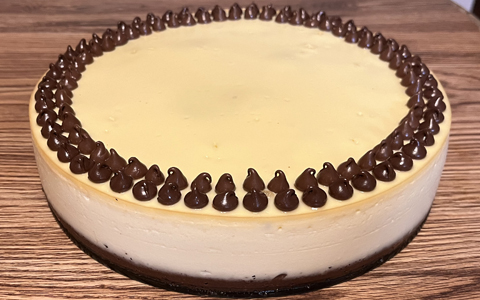
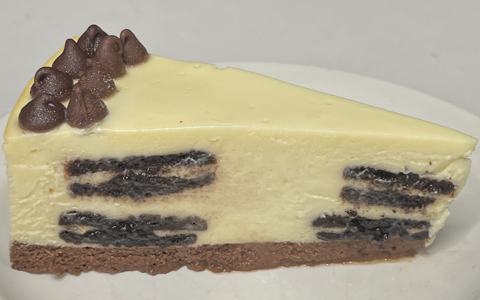
|
|

|